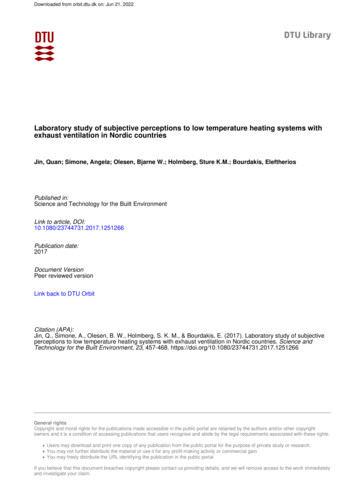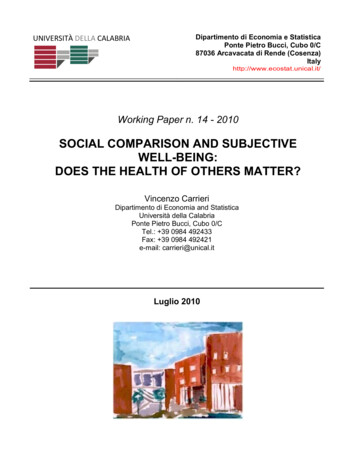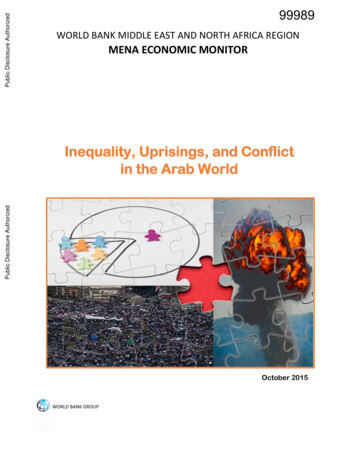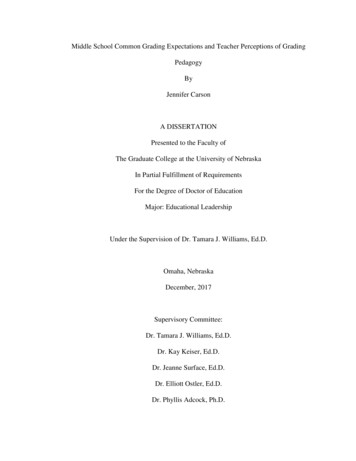
Transcription
Downloaded from orbit.dtu.dk on: Jun 21, 2022Laboratory study of subjective perceptions to low temperature heating systems withexhaust ventilation in Nordic countriesJin, Quan; Simone, Angela; Olesen, Bjarne W.; Holmberg, Sture K.M.; Bourdakis, EleftheriosPublished in:Science and Technology for the Built EnvironmentLink to article, DOI:10.1080/23744731.2017.1251266Publication date:2017Document VersionPeer reviewed versionLink back to DTU OrbitCitation (APA):Jin, Q., Simone, A., Olesen, B. W., Holmberg, S. K. M., & Bourdakis, E. (2017). Laboratory study of subjectiveperceptions to low temperature heating systems with exhaust ventilation in Nordic countries. Science andTechnology for the Built Environment, 23, 457-468. al rightsCopyright and moral rights for the publications made accessible in the public portal are retained by the authors and/or other copyrightowners and it is a condition of accessing publications that users recognise and abide by the legal requirements associated with these rights. Users may download and print one copy of any publication from the public portal for the purpose of private study or research. You may not further distribute the material or use it for any profit-making activity or commercial gain You may freely distribute the URL identifying the publication in the public portalIf you believe that this document breaches copyright please contact us providing details, and we will remove access to the work immediatelyand investigate your claim.
ACCEPTED MANUSCRIPTLaboratory study of subjective perceptions to low temperature heating systems withexhaust ventilation in Nordic countriesQuan Jin1,2,*, Angela Simone3, Bjarne W. Olesen3, Sture K. M. Holmberg1, and EleftheriosBourdakis31Civil and Architectural Engineering, KTH Royal Institute of Technology, Stockholm, Sweden2Civil and Environmental Engineering, Chalmers University of Technology, Gothenburg, SE -412 96, Sweden3International Centre for Indoor Environment and Energy, Technical University of Denmark,Copenhagen, Denmark*Corresponding author e-mail: quan.jin@chalmers.seQuan Jin, PhD, Associate Member ASHRAE, is a Postdoctoral Researcher. Angela Simone,PhD, is a Researcher. Bjarne W. Olesen, PhD, Member ASHRAE, is a Professor. Sture K. M.Holmberg, PhD, is a Professor. Eleftherios Bourdakis is a PhD Candidate.Given the global trends of rising energy demand and the increasing utilization of low-graderenewable energy, low temperature heating systems can play key roles in improving buildingenergy efficiency while providing a comfortable indoor environment. To meet the need to retrofitexisting buildings in Nordic countries for greater energy efficiency, this study focused on humansubjects thermal sensation, thermal comfort, thermal acceptability, draft acceptability andperceived air quality when three low temperature heating systems were used: conventionalradiator, ventilation radiator or floor heating with exhaust ventilation. Human subject tests werecarried out in the climate chamber at the Technical University of Denmark. In total, 24 humansubjects, 12 females and 12 males participated in the tests during the winter season. The results1ACCEPTED MANUSCRIPT
ACCEPTED MANUSCRIPTshow that no significant differences in thermal sensation and thermal comfort between the threeheating systems. Ventilation radiator promised a comfortable indoor environment with adecreased water supply temperature and floor heating with exhaust ventilation can provide abasic thermal comfort level. Thermal acceptability and draft acceptability show variations indifferent heating systems. Gender has significant influences on thermal sensation, draftacceptability and preference of clo values. Personal thermal preference is observed between maleand female. The male prefer to dress lighter than the female but both can get the same thermalcomfort level. It is concluded that low temperature heating systems using exhaust air ventilationare a potentially solution when buildings are being retrofitted for improved energy efficiency andcomfort of the occupants.Key wordsthermal comfort; perceived air quality; low temperature heating; ventilation radiator; floorheating.2ACCEPTED MANUSCRIPT
ACCEPTED MANUSCRIPTAbbreviationsCRconventional radiatorVRventilation radiatorFHfloor heatingNomenclatureTooperative temperature, CTaair temperature, CTsair supply temperature, CTsurfacewindow’s surface temperature, CToutsideoutdoor air temperature, CTrradiator’s surface temperature, CTffloor’s surface temperature, CUheat transfer coefficient of window, W/(m2 K)hheat transfer coefficient of surface, W/(m2 K)IntroductionRetrofitting existing buildings to improve energy efficiency has a significant role to play inreaching the EU Horizon 2020 target for decreasing green gas emission. The renovation ofexisting buildings represents more than 17% of the primary energy savings potential of the EUup to 2050 (Tobias et al. 2012). This gives the chance to reduce energy demand and utilize lowgrade thermal source and renewable energy such as geothermal, waste heat, solar radiation, andetc., which can supply low temperature piped water of 50-55 C (Brand et al. 2012) into building3ACCEPTED MANUSCRIPT
ACCEPTED MANUSCRIPTfor space heating. Concerning both the building side and the source side, low temperatureheating systems are to be implemented during the building retrofit process and in new buildings.In Nordic countries, water based radiator and floor heating are commonly used for spaceheating. Traditionally, radiators are operated with high temperature water supply (75-90 C)(Boerstra 2000). In comparison, low temperature ventilation-radiators operate between 45-35 Cand are more energy efficient in comparison to the conventional radiator (Boerstra and Holmberg2009; Ploskić and Holmberg 2013; Maivel and Kurnitski 2014). Because of the enhancedconvection heat transfer in the radiator, heating efficiency is improved significantly. This wascomprehensively studied and proved by both simulation and laboratory testing (Ploskić andHolmberg 2013; Maivel and Holmberg 2013). In addition to the low temperature heating systemsof floor, wall and ceiling radiant systems (Babiak et al. 2013), the ventilation-radiator is apromising system for buildings being retrofitted.From the occupants’ point of view, comfort of the indoor environment should never beensacrificed for other priorities. The majority of Swedish buildings have since the mid-1900s beenequipped with exhaust ventilation systems, either with or without heat recovery, whereventilation air was brought in directly from the outdoors through the building wall (Myhren2011). In comparison with balanced ventilation or supply and exhaust ventilation, the proportionof exhaust ventilation has been around 60% since 2001 (Svensk Fjärrvärme AB 2009). Somestudies have concluded that fewer health related problems were reported in buildings withexhaust ventilation (Wargocki et al. 2002).However, if the appropriate assessment is not made before construction begins and issuesthat may affect thermal comfort are not identified home energy retrofit activities with low4ACCEPTED MANUSCRIPT
ACCEPTED MANUSCRIPTtemperature heating systems might also negatively affect thermal comfort and perceived airquality. Indoor surveys of apartment buildings located in the north and central regions of Swedenfound that 85% of the buildings were constructed before 1975 (Zalejska-Jonsson andWilhelmsson 2013). The most often observed problem was too low indoor temperature.Moreover, 45% of occupants reported thermal comfort problems on too low or unstabletemperatures, and about 40% of occupant responses also reported stuffy air and 30% reportedsmelly air. Bluyssen s study (Bluyssen 2000) surveyed 26 apartments, during autumn and winter,to gather data pertaining to future building renovation work. The 403 occupant responseshighlighted thermal comfort issues as the main problem including draft and air quality. Stuffyand bad smelling indoor air was also observed due to insufficient ventilation. Also, exhaustventilation systems have the potential to generate cold drafts near the window. Traditionally,radiators are installed under the window to counteract the down draft and make occupants feelcomfortable. In low temperature water supply systems, the surface temperature of radiator islower than conventional radiator. As a result, there’s greater potential for occupants toexperience more cold draft near the window. Floor heating system shares this potential for drafts.In the previous study, thermal comfort was checked by computational fluid dynamicssimulation under the arrangements of ventilation radiator and inlet of cold air fitted betweenradiator panels, and conventional radiator and inlet of cold air above the window (Myhren andHolmber 2009). The simulated results showed that the comfort temperature was 21.0 at 1.1 mabove floor level in the room centre, but it was more favourable and stable thermal climate withventilation radiator system under the given conditions in comparison to the conventional radiatorsystem. There were small temperature variations because of a pre-heated cold air and a large5ACCEPTED MANUSCRIPT
ACCEPTED MANUSCRIPTtemperature differences in the area close to the window wall under conventional radiator system.In an early study, radiator system and floor heating system were both tested in a well-insulatedtest room (Olesen et al. 1980). The air infiltration was simulated around the window. When thetemperature level in the room provided thermal neutrality, there would be a small likelihood oflocal discomfort. Under floor heating system, there was a risk of mean air velocity higher than0.1 m/s along the floor when the down-draft along the window was not counteracted by anupward convection. However, no subjective study was further carried out to check the actualthermal comfort with the given conditions. In addition, local discomfort or local thermalsensation and gender differences were not checked. Local thermal sensation has been proved tobe a significant influence on overall thermal sensation and local discomfort may cause an overalldiscomfort perception (Arens et al. 2006; Jin et al. 2011). Also, a growing number of studieshave found significant differences of thermal comfort between genders (Fanger 1970;Karjalainen 2012). The perceived indoor environment under low temperature water basedradiators in which the water is generally below 45 C, has not been adequately studied. Hence,the relative thermal comfort of ventilation radiators or floor heating combined with exhaustventilation must be ascertained before choosing the type of low temperature heating systems in abuilding retrofit.Given the high cost of replacing exhaust air ventilation, in Sweden, the question of whetherthermal comfort condition can still be maintained or improved by different low temperatureheating systems is uncertain. The present study focused on the outcomes of human subjectassessments to compare indoor environments equipped with three different low temperatureheating systems: conventional radiator, ventilation radiator and floor heating with exhaust6ACCEPTED MANUSCRIPT
ACCEPTED MANUSCRIPTventilation. The typical parameters of buildings built before 2000 was defined the generalcontext of the testing. The work addressed the possibilities and limitations in using lowtemperature heating systems in building retrofits.MethodsIndoor environment chamberThe study was carried out in an indoor environmental chamber at the International Centrefor Indoor Environment and Energy (ICIEE) at the Technical University of Denmark (DTU)(Toftum 2004). The chamber has a net internal dimension (l b h) of 4.2 m 4.0 2.7 m. Thebackground sound pressure level is less than 35 dB. All the materials used in the chamber havelow sensory emission characteristics (Toftum 2004). A uniform lighting was provided by highfrequency fluorescent lamps. Figure 1 shows the setup of different heating systems installed inthe chamber: the conventional radiator under the window, the ventilation radiator under thewindow, the floor heating over the chamber floor.All the walls were thermally insulated and the heat transmission coefficient was 0.25 W /(m2 K). The window’s heat transfer coefficient was equivalent to 2.1 W / (m2 K) which istypical in buildings built between 1975 and 2000 in Sweden and Finland. The window wassimulated by cooling panels positioned in the front wall with an area of 6.4 m2. The bottom partwas thermally insulated by polystyrene board.The chamber was set up to mimic a living room in a typical residential unit with one bigtable, two chairs, two computers, two shelf and some decorated paintings. They were arranged ina symmetrical layout with two persons sitting inside the occupied zone as shown in Fig. 2.7ACCEPTED MANUSCRIPT
ACCEPTED MANUSCRIPTHeat emittersThere were three heating emitters installed inside the chamber, including a conventionalradiator (CR), a ventilation radiator (VR) and floor heating (FH). CR and VR were installedbelow the simulated window and positioned on the central line of the chamber. The dimensions(l h) for CR and VR were 500 mm 1200 mm. CR is a two-panel radiator where one panel hasconvection fins. VR is a two-panel radiator where two panels have convection fins. In contraststo CR, the ventilation radiator combines the conventional radiator with an air-supply ventilationdiffuser. The supplied air is conducted to the channel between the two panels of the conventionaldouble pane radiator as preheated and then enters into the indoor environment. FH was alreadyinstalled over the original chamber floor and separated from it by a layer of insulation board(Causone et al. 2010). The heating pipes were embedded into the panels which had three layers:a wooden frame 12 mm thick, an insulation layer 15 mm thick and an aluminium plate 3 mmthick. The aluminum plates helped a uniform surface temperature distribution. The floor wascovered by plastic flooring on top.Ventilation strategyThe ventilation strategy in the tests was exhaust ventilation. The supplied air wasconditioned through the climatic air-conditioning system and a cool box. There were twoarrangements of air inlet. With CR and FH systems, the air was supplied from a wall diffuserwith a dimension of 215 mm 156 mm which located just above the window on the symmetryaxis of the chamber. With VR, the air inlet was at the bottom and on the symmetry axis of theradiator which was used to supply the outside air into the room. Before getting into the channel8ACCEPTED MANUSCRIPT
ACCEPTED MANUSCRIPTformed by the radiator panels, the air passes through a wall channel and a filter, which canprevent particles in the supplied air from reaching the indoor environment. The air exhaustterminal was on the bottom level at left side wall.Measuring instrumentsFigure 3 shows the measure points for air temperature, operative temperature, surfacetemperature and the reference point. The operative temperature (To) at the reference point,positioned in the center of the chamber with a height of 1.1 m, was measured by a globethermometer of a 40 mm diameter. The air temperature (Ta) at the reference point was measuredby a thermistor shielded from radiant heat exchange. The relative humidity (RH) was recordedby a data logger having an accuracy of 2.5 %. The temperature sensors with data loggerstogether were calibrated in a range of 15 C to 26 C resulting on a temperature reading accuracyof 0.3 C. The air temperature and operative temperature were also tested at the edge ofoccupied zone close to the window at a height of 0.6 m. Air velocity was measured at thereference point with heights of 0.1 m at foot level and 1.1 m at head level. Omnidirectional hotsphere anemometers were used and connected to a control unit multichannel flow analyser withan accuracy of (0.02 0.02 Reading) m/s.The surface temperatures of window, radiator, floor and walls were measured by thermistorsensors with an accuracy of 0.3 C. The thermistor sensors were flat and in order to secure agood thermal contact with the surface, thermal paste and aluminum tape were used to cover thesensor.The environment chamber no. 3 in DTU was used to calibrate temperature sensors. Thechamber provided conditioned air uniformly from the floor to the ceiling and also passed through9ACCEPTED MANUSCRIPT
ACCEPTED MANUSCRIPTthe thin textile layers of the walls to control air temperature and radiant temperature. By meansof this design the chamber had a low thermal mass to have the temperature changed rapidly.A 23 body segment thermal manikin was used to calculate the clothing insulation (Tanabeet al. 1994; ISO 1991). There were two sets of the clothing worn during the tests one jacket-onand the other jacket-off. The overall clothing included underwear, T-shirts (cotton), long sleeveshirt, sports jacket and jeans. Tests of the manikin found that the clothing thermal insulationvalues were 1.07 with jacket and 0.74 without jacket.Human subjects surveyThe subjective survey was carried out by paper questionnaires that included specificquestions (in accordance with ISO 10551) on overall thermal sensation, local thermal sensation,thermal comfort, thermal acceptability, draft acceptability, perceived air quality and also generalquestions on other indoor factors such as acoustic and illuminative comfort etc. (ASHRAE 2013;ISO 2005; Fanger et al. 1988; ISO 1995).Fig. 4 shows the scales of surveyed items in the questionnaires. Thermal sensation wassurveyed by the 7-points continuous scale (ISO 2005). Thermal comfort used a continuous scaleranged from comfortable to very uncomfortable: 4 (comfortable), 3 (slightly uncomfortable), 2(uncomfortable), 1 (very uncomfortable). Acceptance of the thermal environment was voted by asplit scale:4 (clearly acceptable), 3 (just acceptable), 2 (just unacceptable), 1 (clearlyunacceptable). Subjects were asked to vote on air movement which had the same numericalvalues as thermal acceptance. Perceived air quality was evaluated by air freshness ranging fromfresh air to stuffy air which was split in the middle by points of “just fresh” and “just stuffy”. Thescale values were 1 (fresh air), 2 (just fresh), 3 (just stuffy), 4 (stuffy) (Fanger et al. 1988; ISO10ACCEPTED MANUSCRIPT
ACCEPTED MANUSCRIPT1995; Gunnarsen and Fanger 1995).Twenty four human subjects were selected to participate in the tests, 12 males and 12females. They all had at least one and half years’ living experience in the Nordic climate. Theysubmitted to the requirements of being healthy, non-alcoholic and during the test period theyavoided caffeine drinks and perfumes. The following table displays the subjects’ anthropometricinformation. Measures of body mass index and body fat percentage (calculated by measuring thecircumferences of certain body parts) (Hodgdon and Beckett 1999) identified a mix of normalweight, overweight, and obese subjects (WHO 2006).Subjects were relaxed reading and typing on the laptop, so metabolic rate was evaluated as1.0.Data analysisThe subjective votes taken during the last hour of the experimental period (3.5 hours) wereanalyzed and the results from three different experimental conditions were compared regardingthe votes of thermal sensation, thermal comfort, thermal acceptance and perceived air quality.The individual votes were plotted for each heating system. The mean values were compared inrelation to different heating systems. The influence of the subjects’ gender was also investigated.Statistical methods were performed to generate a significant reference. T-test method andAnalysis of Variance (ANOVA) were used to determine the significance of the differencebetween the three heating systems.In total, there were 72 tests and the sample size in each heating system was 24. Resourcelimitation was one reason to fix the sample size, while the required sample size was also checkedby power analysis of hypothesis test (Lenth 2001; Cohen 1988) as to be of scientific significance.11ACCEPTED MANUSCRIPT
ACCEPTED MANUSCRIPTA two-sided test was set up with a required effect size and 80% power when the significant levelwas 0.05. The required sample size was 15 for Paired T-test and required total sample size was24 for two groups T-test. As a result, the sample size in this study was fixed as 24. It may not be“big enough”, however the sample data also broadened the study scope considering differentanthropometric information, gender and multiple heating systems.Experiment ProgramExperimental procedureThe subjects have been exposed 2 by 2 to all three built environmental conditions for threeand half hours each. In the beginning, subjects stayed in a neutral and uniform environment withair temperature of 22 C for half an hour before entering into the test chamber. This was apreparation time to explain the questionnaires and to change the required clothing. After the teststarted, the first two hours were used to have the subjects reach a steady state on the metaboliclevel and a stable thermal sensation. Subjects recorded one vote at the end of the first hour andtwo votes in the second hour. At the last hour, subjects filled into the questionnaire every twentyminutes. See Fig. 5. During the test, subjects were free to take the jacket on or off in the first twohours, according to own thermal preference at home. At the start of the last hour, the subjectswere prompted to decide whether to wear the jacket or leave it off.Boundary conditions and physical conditions measuredThe winter season is from November to March in most Nordic climates. The average wintertemperature in Helsinki, Stockholm, and Copenhagen is around -4 C, 0 C, and 5 C respectively.Accommodating to the lowest temperature that air could be cooled, the supply air temperature12ACCEPTED MANUSCRIPT
ACCEPTED MANUSCRIPTwas set at 5 C for the three heating cases. It was not an extreme winter temperature but thistemperature level can be a preliminary exploration from the perspective of subjective surveys.In residential buildings, the required air changes rate (ach, 1/h) is no less than 0.5 ach to 1ach. Meanwhile according to the minimum fresh air needed which is 0.35 l/s per m2 and 6 l/s perperson for an acceptable indoor environment in building regulations, the air changes rate used inthe test was 1 ach which meant air supply volume was 12.6 l/s for the chamber with two subjects(BBR 2011; D2 2012).The simulated window’s inner surface temperature was calculated according to outdoor airtemperature Tout , indoor air temperature Ta and heat transfer coefficient of window U andsurface heat transfer coefficient h . See Eq. (1).Tsurface Ta U(T T) (1)h a outsidewhere h is heat transfer coefficient in an average condition including the effects of convectionand radiation heat transfer. An average value of 7.6 W/(m2 K) was used according to findings byothers (Griffin et al. 1996; Moshfeg et al. 1999; Jurelionis and Isevicius 2008).The internal heat loads included metabolic heat production (60 W/person), four lights (72W), and two laptops (80 W). Table 2 shows the boundary conditions for the test design and table3 shows the physical conditions measured during the tests as a comparison. For the air velocity,only mean values higher than 0.05 m/s are listed. Only with floor heating system, a mean airvelocity was measured higher than 0.15 m/s. The surface temperature of window, radiator andfloor shown in the table is an average value calculated from several sensors along the surface.From the measurements, the water supply temperature to CR, VR and FH system was 44 C,13ACCEPTED MANUSCRIPT
ACCEPTED MANUSCRIPT35 C and 30 C respectively which meant the three heating systems were operating as lowtemperature and even very low temperature heating systems (Eijdems and Boerstra 2000).The clo values were observed during the test. See Fig.6, showing the clo levels of each subject inthe test of different heating systems. In average, the clo value of female is 1.06 0.05; the clovalue of male is 0.8 0.13.ResultsThe distribution of experimental data from human subject testsThe individual votes in each heating system are shown in Fig. 7 in detail: thermal sensationvote, thermal comfort vote, thermal acceptability vote, perceived air quality vote and draftacceptability vote. Each diagram displays standard deviation, mean value, median value and minand max values. The mean vote in each heating system is connected with a trend line. Thestandard deviation reveals individual differences existing on the surveyed variables.The mean value of the sample results was calculated and described as a range with a 95%confidence interval. The interval means there is 95% probability that the mean value will fallwithin this range. Thus, instead of only the mean value, it makes sense to give the entire rangerepresenting different perceived levels with each heating system. See table 4. The result ofthermal sensation is between neutral to slightly cool for the three heating systems. The results ofthermal acceptability and perceived air quality are in the range of just acceptable and just freshrespectively. It’s slightly uncomfortable in CR and FH and slightly uncomfortable to comfortablein VR. Draft acceptability in CR is clearly acceptable, in FH is just acceptable and in VR is justacceptable to clearly acceptable.14ACCEPTED MANUSCRIPT
ACCEPTED MANUSCRIPTThe influences of heating system and gender on thermal perceptions and perceived air qualityThe mean values shown in table 4 do not represent any significant differences. The followinganalysis of variance (ANOVA) was used to verify the influences of heating system and genderon the voting results. The significant test level is 0.05. Table 5 shows the significant p value.Results indicate that the two factors of heating system and gender both have significant influence.Heating systems have significantly effects on thermal acceptability and draft acceptability. Thereis no significant difference in thermal sensation between the three heating systems which agreeswith the result in table 4. This is also the same result of perceived air quality. As for thermalcomfort, there is no significant influence from heating systems although a different level of meanvote can be observed in table 4. As for gender, it has a significant influence on thermal sensationand draft acceptability. The cross influence of heating system and gender is not significant to thesurveyed variables.The comparison of mean values under different heating systemPaired T-test is used to compare the means. In Fig.8, the mean values of thermalacceptability are given with a 95% confidence interval. The numerical value is from the votingscale. The corresponding perception is listed on the vertical axis. Even though the mean valuesof the three heating systems are in the same level of just acceptable, the minor differencesbetween CR and FH, and VR and FH are significant. The result is interpreted as subjects feel abit more comfortable in CR and VR comparing with FH.The perceived levels of the air draft in each heating system shows significant differences.See Fig. 9. Regarding how the subjects felt the air movement, the mean values of draft15ACCEPTED MANUSCRIPT
ACCEPTED MANUSCRIPTacceptability in CR and VR are significantly different from FH: it is clearly acceptable in CR andVR and just acceptable in FH.The comparison of mean values under different gender groupTo track gender’s significant influence on thermal sensation and draft acceptability, thefollowing figures compare the difference of mean values in each gender group in the surveyedvariables and heating systems. T-test is used to compare the means in a significant level of 0.05.Fig. 10 shows the mean values of thermal sensation perceived by males and females. The leftdiagram divides the gender group from the total samples in the three heating systems. The resultshows the difference of numerical values between females and males is significant. Females feelwarmer than males for which the sensation is between slightly cool to neutral and the latter isslightly cool. This significant difference is also found in CR system for which females feelneutral and males feel slightly cool as shown in the right diagram.The subjects also experienced air movement differently by gender. See Fig. 11 which showsthe mean values of draft acceptability. If data from the three heating systems is divided bygender, the acceptance of cold draft in the female group (clearly acceptable) is somewhat higherthan in the male group (just acceptable).The mean values’ comparison for the other surveyed variables of thermal comfort, thermalacceptance and perceived air quality are not presented here as there is no significant genderdifference shown between the different heating system.16ACCEPTED MANUSCRIPT
ACCEPTED MANUSCRIPTPerceived cold sense on partial body segment under different heating systemThe percentage of subjects who experienced a cold feeling on a specific body segment isdisplayed in Fig.12. Subjects were asked to log their perceptions of cold on 11 body partsincluding back, shoulder, neck, head, face, chest, arm, hands, thigh, lower leg and feet. Thepercentage of the perceived cold sensation was calculated from the votes. In all three heatingsystems, as high as 70% of the subjects reported cold feet. In the lower leg region, more subjectsreported a cold sensation in FH, followed by CR and then VR. There were also more coldfeelings reported in hands, face, neck and chest with the floor heating system. By contrast, fewersubjects reported cold sensations in the partial body segment in VR.DiscussionComparisons of three low temperature heating systems on perceived thermal environmentThe above results in table 5 show no significant difference in thermal
for space heating. Concerning both the building side and the source side, low temperature heating systems are to be implemented during the building retrofit process and in new buildings. In Nordic countries, water based radiator and floor heating are commonly used for space heating.










